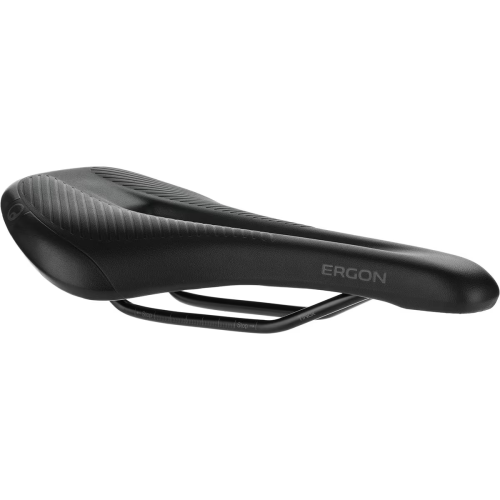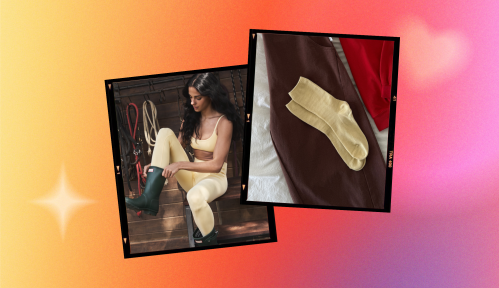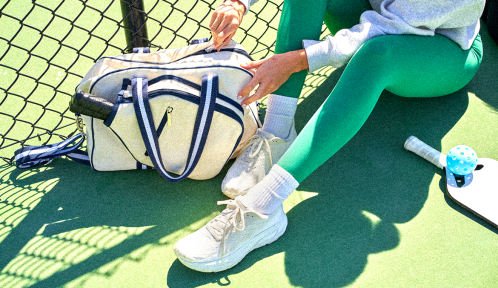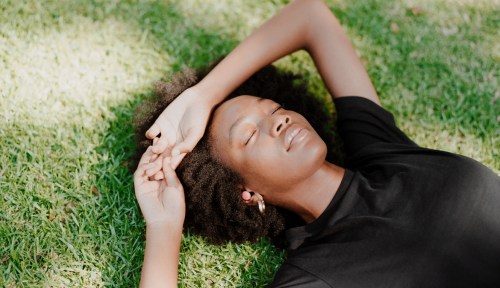Our editors independently select these products. Making a purchase through our links may earn Well+Good a commission
Indoor biking, either at home or at a spin class, has become more enticing (and popular) than ever thanks to high-quality set-ups and a variety of tech to keep it interesting. Gone are the days of staring at a blank wall while counting the very sweaty minutes until you are freed from being “behind bars”—handlebars, that is. But one thing we still have to deal with? How much stationary bike seats hurt.
Experts in This Article
physical therapist and owner of Pedal Fit, a bike fitting studio in Denver, Colorado
Minnesota-based Life Time cycle instructor and studio lead
A stationary bike can (and should!) be comfortable enough for you to enjoy a spin class or ride without constantly shifting around on the seat. And figuring it out is worth it, too, because spinning is more than just a fun way to get in your daily dose of exercise: An August 2019 systematic review published in Medicina1 states that “indoor cycling may improve aerobic capacity, blood pressure, lipid profile, and body composition.”
Here’s how to make sure the next time you hop onto a spin bike isn’t just one big pain in the butt, literally.
Why do stationary bike seats hurt so bad?
Some of the most common complaints from spin bike users is that their crotch and buttocks areas are in pain during and after a ride.
There can be many reasons for this discomfort, but seat height and fore/aft (how forward or backward the seat is) often plays a role, according to Minnesota-based Life Time cycle instructor and studio leadSydney Samborski.
“If a bike seat is too low, a rider may place too much weight on the saddle, leading to unwanted pressure of the soft tissue. If a bike seat is too high, a rider may rock back and forth on the saddle, causing friction or chafing in the groin area,” Samborski says. “I do caution new riders that there may always be some level of minor discomfort from sitting on a bike saddle, such as muscle soreness in the glute muscles. This is normal and your buttocks will become more used to the saddle over time and feel less sore.”
How you sit on a spin bike seat can also influence whether or not you feel pain, according to Natalie Collins, DPT, COMT, BikePT, physical therapist and owner of Pedal Fit, a bike fitting studio in Denver, Colorado.
“Ideally, you want to feel pressure on the saddle in about a three-inch range in front of the sit bones, which are the bones you would feel if you’re sitting straight in a chair,” Collins says. “Many riders sit too far back on their buttocks, which can cause a rounded pelvis and lead to both low back and buttocks pain.”
Collins also notes that some spin bikes come with very wide saddles, which may not be the right size for all riders.
“If the saddle on a spin bike is too wide, riders may feel pressure near where the thighs meet the soft tissue and buttocks areas as they rock side to side to try to accommodate for the wide saddle,” Collins says.
Fortunately, most spin bike seat pain can be remedied by learning how to properly adjust a spin bike to your measurements, choosing the right bike seat for you, and following general best practices for crotch and buttocks hygiene while indoor cycling.
Proper setup of a spin bike
Taking time to learn how to properly set up a spin bike for your height, weight and needs is worth it, says Samborski.
While standing next to the bike at a 90-degree angle facing in the direction the bike is facing, the top of the bike seat should be at about hip height.
Handlebar height is more of a personal choice, Samborski says, but general best practice here is to ensure that your spine is in a neutral position regardless, which means no arched back and no extremely rounded back.
“Once the seat and handlebar heights are established, I tell riders to move seat and/or handlebars fore/aft such that they can fit one forearm length plus one fist width between the nose of the bike seat and the end of the handlebars that faces toward the rider,” Samborski says. “You can make smaller adjustments as needed, but these are the general guidelines I use.”
Collins suggests discovering your personal preference with seat angle, too.
“I don’t recommend putting a leveling tool on your bike seat and assuming that ‘zero’ is the right angle for you,” Collins says. “Instead, find the bike seat angle that allows you to sit in the correct place on the saddle, without extreme back or knee positions and with your feet level to the ground.”
The amount of pressure your soft tissue and buttocks should feel against the saddle is akin to “pressing your forearms together with minimal effort,” Collins suggests.
Collins adds that ensuring the spin bike is on a level surface is critical to achieving spin bike seat comfort.
“Some spin bikes may have adjustable feet, but many do not,” Collins says. “Placing a piece of plywood or other sturdy flooring beneath the bike, especially if it’s on carpet, can be helpful in creating a level surface for the bike. The last thing you want is to be favoring one side or tilting to one side because the floor isn’t level.”
Choosing the right bike seat
Sometimes, even after adjusting the spin bike to your measurements and ensuring the bike is level, a stationary bike seat still hurts, because it just doesn’t work with your anatomy—and that’s OK.
Most spin bikes provide the option to swap out bike seats with the twist of a few bolts. But beware: Opting for a plush bike seat straightaway may not solve all of your problems.
Beware: Opting for a plush bike seat straightaway may not solve all of your problems.
“Softer, cushier bike seats are not always the answer,” Collins cautions. “If you’re already feeling a lot of pressure or rubbing from your existing bike seat, a wider or softer bike seat will only exacerbate those problems as softer bike seats’ foam or gel fillings can ‘collapse’ over time, causing the bike seat to lose its initial shape.”
Instead, Collins has three bike seats she recommends, with the caveat that every rider should consult with a veteran spin class instructor, bike fitter, or physical therapist to determine what saddle is right for them.

Selle Royal Respiro, Athletic — $70.00
“This saddle is on the softer side, but does not break down in the middle over time as other soft saddles do,” Collins says. “It is a really nice choice for people with a slightly wider pelvis or who ride without a chamois, or padding, in their shorts. This saddle also is great for those who prefer to sit in a more upright position than a forward position.”

Ergon SM Comp — $100.00
“This is a flatter saddle, so for folks who like to move around on their bike seat as they ride, this is a nice option, and it’s a good bike seat for people who like to be in a medium-forward trunk angle,” Collins says. “The majority of people will do well with a size medium/large, but if you have a narrow pelvis, a small/medium would be a solid choice.”

Specialized Power Comp — $140.00
“This bike seat is ideal for people who wear a chamois pad when they ride and who prefer to ride in a more forward-tilted pelvis position, such as the traditional position on a road or gravel bike,” Collins says. “The 143mm size will be the right size for most people—the 155mm may work for some, but you do run some risk of starting to get into too much pressure between the saddle and soft tissue with that size for most.”
Run Smarter, Not Harder: Nike’s Running Shoe Finder Takes the Guesswork Out of Choosing Sneakers

Flares! Wide-Legs! Cargos! Here Are 5 Nike Pairs to Help You Celebrate the Active-Pants Renaissance

These Leggings Give You a Lymphatic Drainage Massage While You Walk—Here’s What Happened When I Tried Them

Best practices while cycling to make the stationary bike seat hurt less
Following general guidelines for crotch and buttocks care while using a spin bike can go a long way in finding comfort.
Use resistance smartly
Samborski recommends viewing the resistance knob on spin bikes as a “measure of challenge and a tool of support,” not something to crank up willy-nilly. Adding too much resistance (or not enough) can cause unnecessary rocking or rubbing against the bike seat, which can result in chafing or sore soft tissue.
“Think about feeling a controlled push and pull through every stroke of your pedals,” Samborski says. “That’s how you’ll know you’re using the right level of resistance—plus, following along with the appropriate resistance cues from a spin class instructor will help you find the ride more physically and mentally engaging instead of haphazardly cranking up or down on the resistance knob.”
Add a fan
Collins suggests “pointing a fan right at your butt” while you ride indoors, too.
“When riding indoors, we don’t get the benefit of being outside where evaporative cooling and the wind help to alleviate sweat buildup in the crotch and buttocks area,” Collins says. “Using a fan pointed at your behind while you ride indoors can help prevent skin lesions and other bike seat irritations.”
Wear the right shorts
Additionally, Collins advocates that indoor riders use bike shorts with a chamois (or “shammy”) pad in them. A chamois pad is simply the padding in the crotch and buttocks area of bike shorts. It can vary in thickness and size depending on the brand and use-case (indoor riding vs. mountain biking chamois are quite different in thickness, for example).
“Make sure the padding sits in the right spot—not so wide as to be rubbing on the inside of your thighs and not so long as to be riding up the front or back of your nether regions,” Collins says. “Bike shorts should be relatively tight, and bib short bike shorts take it to another level for those who really want to keep their bike shorts in place while they ride.”
Spin bike seats may never be as comfy as a lounge chair—but neither is pushing yourself to a new limit in a sweaty workout. Ensuring that your spin bike is properly set up for your measurements, level, and with a good saddle are great ways to make the time on your indoor bike a comfortable, rewarding experience.
Chavarrias M, Carlos-Vivas J, Collado-Mateo D, Pérez-Gómez J. Health Benefits of Indoor Cycling: A Systematic Review. Medicina. 2019; 55(8):452. https://doi.org/10.3390/medicina55080452
↩︎
Sign up for the Well+Good SHOP Newsletter
Get exclusive deals on wellness, beauty, fitness, and food products that have been hand-picked by our editors.
Got it, you've been added to our email list.







